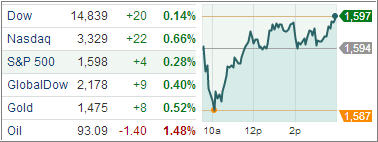The bulls simply don’t know how or when not quit as stocks ended Tuesday’s session on a modestly higher note in the face of another day of mushy global economic data. The Dow Jones Industrial Average moved up 21 points (or 0.1%) to 14,839, the Nasdaq Composite gained 22 points (0.7%) to 3,329, and the Standard & Poor’s 500 Index added 4 points (0.3%) to 1,598, sending the S&P index to another record. In moderate volume, more than 6.7 billion shares changed hands on U.S. exchanges, or 5 percent higher than the three-month average. Techs led the way again with Apple launching $17 billion of bonds in the biggest corporate offering on record.
A decline in regional business activity underlined the growth concerns of the economy. The Chicago Business Barometer dropped 3.4 points in April to 49.0, falling into contraction territory for the first time since September 2009. Economists forecasted a small uptick to 52.8.
Production, supplier deliveries, inventories, and order backlogs indexes were at their lowest levels since 2009. Employment fell for the second time in the past five months. Price pressures eased, as the prices index fell to 51, the lowest level since October 2009, reflecting softer demand. Milwaukee activity contracted for the first time in five months, as the composite index declined 2.6 points to 48.4. New orders, production and employment each shrank but, thanks to the stimulative efforts of the Fed, none of the above matter anymore.
The seasonally-adjusted S&P/Case-Shiller home price indexes continued to rise in February, reflecting the ongoing recovery in the housing market. The 10-city and 20-city composite indexes gained 1.2% each, posting their biggest increases since 2005. Prices rose in all 20 metro areas, and exceeded 1.0% in half of them.
On a year-to-year basis, prices are up about 9%, the fastest pace since May 2006. Despite near-record housing affordability, the homeowner ship rate fell to 62.5% in Q1, the lowest rate since 1995. This suggests a lot of the buying has been done by investors, who then rent out their properties. As a result, the rental vacancy rate has declined to 8.6%, the lowest since 2002.
According to the Conference Board, confidence among U.S. consumers climbed more than forecast in April to a five-month high as Americans’ outlook for the economy and their incomes improved.
The overall backdrop of the economy is still negative; the market continues to draw support from expectations that the Federal Reserve is having its back with current policy. The central banks are believed to maintain low interest rates and other economic stimulus measures.
A statement from the Fed due tomorrow is expected to keep in place the pace of bond buying to stimulate the economy. The European Central Bank will meet on Thursday and policymakers too are expected to cut interest rates.
Our Trend Tracking Indexes (TTIs) rallied with the indexes with the Domestic TTI closing the month at +4.08%, while the International TTI ended at a point that is +8.14% above its long term trend line.
Be sure to tune in tomorrow morning when I will post the latest ETF Model Portfolio update.
Contact Ulli
